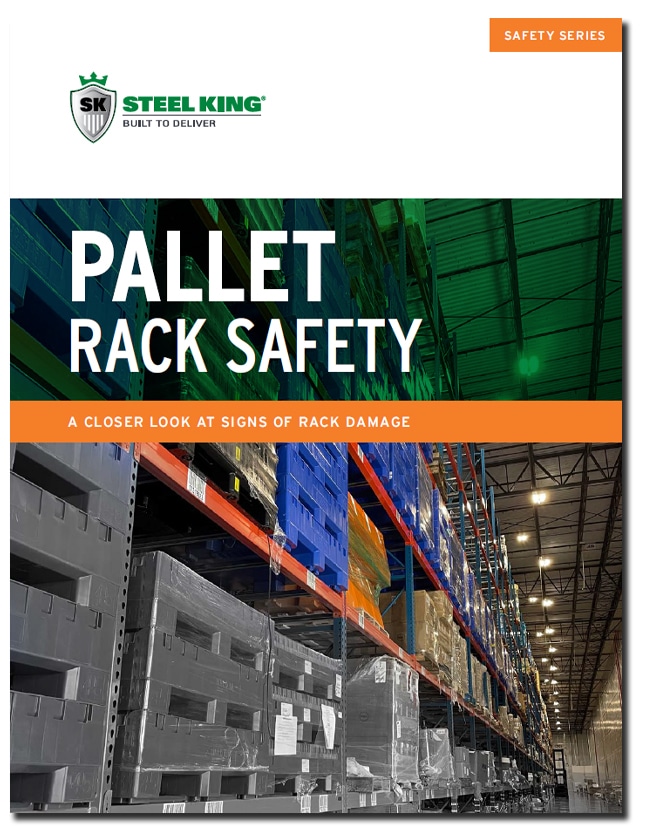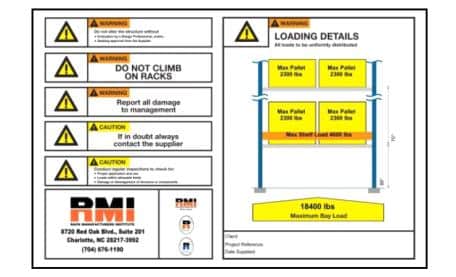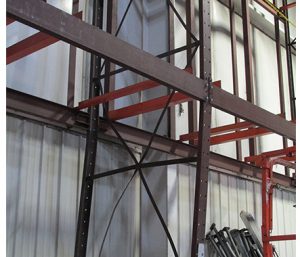Fire Protection Is a Key Part of Design of Warehouses with Pallet Racks
Planners Need to Be Aware of Pending Code Changes Fire protection is always a...
Read ArticlePallet rack can be a great asset to your company, helping you make the most of your storage space and optimize the organization of your products.
However, when rack is damaged or incorrectly loaded or installed, it can become dangerous.
 Periodic visual inspections will not only help you comply with safety regulations and work more safely, it will help you spot poor practices in your operation that might otherwise go unnoticed.
Periodic visual inspections will not only help you comply with safety regulations and work more safely, it will help you spot poor practices in your operation that might otherwise go unnoticed.
Even the best-built pallet rack can sustain damage. When racks are overloaded or are damaged, it can compromise a rack’s capacity and put your system at risk. Let’s face it, drivers are not always inclined to report collisions, so you may not know in a timely manner if a rack has been compromised.
It’s well worth your time to schedule regular inspections. The sooner you know about a damaged upright, the sooner you can replace or repair it. Don’t wait for an inspector to tell you. New uprights are relatively inexpensive; a rack collapse is not.
It is crucial to check that your rack is not carrying more load than it’s designed for. To calculate your required beam capacity:
While calculating your rack capacity needs is pretty straightforward, it is still advisable to have a material handling professional to confirm your calculations. They’ll have important considerations and information.
When designing a rack system, there are many other factors that come into play – from seismic zones to floor thickness to bracing patterns. It is strongly suggested that you contact a material handling expert.
 Always be sure to install a capacity plaque on each rack area, including the following information: loads per shelf, level and bay, rack manufacturer, beam sizes, and upright frame size..
Always be sure to install a capacity plaque on each rack area, including the following information: loads per shelf, level and bay, rack manufacturer, beam sizes, and upright frame size..
If you’d like help figuring out your rack requirements, give us a call. Steel King’s rack design expert are glad to help. For more information, on capacity, download our rack safety guide.
While any areas of your facility can sustain damage, some storage areas are inherently more prone to incur forklift impact. These should be inspected more frequently and more thoroughly:
The answer to those questions is highly situation dependent. Recognizing that every storage rack application and operation is different, RMI’s publication Considerations for the Planning and Use of Industrial Steel Storage Racks recommends only that the system owner establish and implement a program of regularly scheduled inspections, offering guidelines to determine frequency. Additionally, systems should be inspected immediately after any event increases the likelihood of damage to the rack – such as a forklift collision or a seismic event.
At a minimum, inspections should be performed annually. A best practice rule of thumb, however, is that inspection frequency should correspond to the higher the velocity of inventory throughput, traffic or activity in the racking.
Buying the right warehouse racks is one of the best business investments you can make. Your racking system delivers an enormous return on investment by maximizing your space usage, minimizing your product turnover time and delivering a safe working environment for your employees. In addition, some rack styles are inherently more durable and impact-resistant.
Rack structure considerations:

Though they may cost more up front, pallet rack systems that are built better from the beginning can save on costs throughout the lifetime of a pallet rack system.
 While a visual review is not a thorough inspection, it’s a valuable first alert!
While a visual review is not a thorough inspection, it’s a valuable first alert!
Having a thorough checklist and an inspection schedule will help you keep on top of potential issues. Documentation helps you track the regularity and thoroughness of the inspection process.
These tips provided here are for informational purposes; see a rack inspection professional for a thorough rack inspection. When hiring a inspectors, be sure they adhere to industry or local code standards, and that they also document and retain the records of their inspections.
For additional information, please see OSHA’s guide to Materials Handling & Storage.